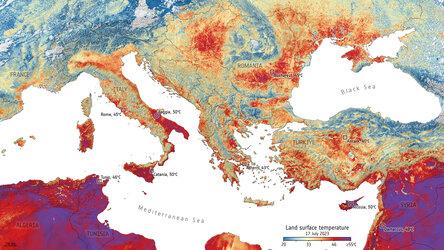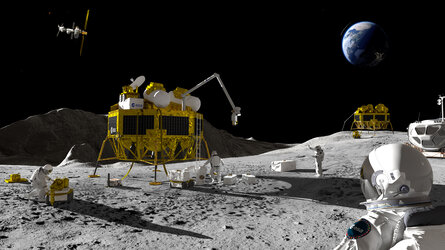Accept all cookies Accept only essential cookies See our Cookie Notice

About ESA
The European Space Agency (ESA) is Europe’s gateway to space. Its mission is to shape the development of Europe’s space capability and ensure that investment in space continues to deliver benefits to the citizens of Europe and the world.
Highlights
ESA - United space in Europe
This is ESA ESA facts Member States & Cooperating States Funding Director General Top management For Member State Delegations European vision European Space Policy ESA & EU Space Councils Responsibility & Sustainability Annual Report Calendar of meetings Corporate newsEstablishments & sites
ESA Headquarters ESA ESTEC ESA ESOC ESA ESRIN ESA EAC ESA ESAC Europe's Spaceport ESA ESEC ESA ECSAT Brussels Office Washington OfficeWorking with ESA
Business with ESA ESA Commercialisation Gateway Law at ESA Careers Cyber resilience at ESA IT at ESA Newsroom Partnerships Merchandising Licence Education Open Space Innovation Platform Integrity and Reporting Administrative Tribunal Health and SafetyMore about ESA
History ESA Historical Archives Exhibitions Publications Art & Culture ESA Merchandise Kids Diversity ESA Brand CentreLatest
Space in Member States
Find out more about space activities in our 23 Member States, and understand how ESA works together with their national agencies, institutions and organisations.
Science & Exploration
Exploring our Solar System and unlocking the secrets of the Universe
Go to topicAstronauts
Missions
Juice Euclid Webb Solar Orbiter BepiColombo Gaia ExoMars Cheops Exoplanet missions More missionsActivities
International Space Station Orion service module Gateway Concordia Caves & Pangaea BenefitsLatest
Space Safety
Protecting life and infrastructure on Earth and in orbit
Go to topicAsteroids
Asteroids and Planetary Defence Asteroid danger explained Flyeye telescope: asteroid detection Hera mission: asteroid deflection Near-Earth Object Coordination CentreSpace junk
About space debris Space debris by the numbers Space Environment Report In space refuelling, refurbishing and removingSafety from space
Clean Space ecodesign Zero Debris Technologies Space for Earth Supporting Sustainable DevelopmentLatest
Applications
Using space to benefit citizens and meet future challenges on Earth
Go to topicObserving the Earth
Observing the Earth Future EO Copernicus Meteorology Space for our climate Satellite missionsCommercialisation
ESA Commercialisation Gateway Open Space Innovation Platform Business Incubation ESA Space SolutionsLatest
Enabling & Support
Making space accessible and developing the technologies for the future
Go to topicBuilding missions
Space Engineering and Technology Test centre Laboratories Concurrent Design Facility Preparing for the future Shaping the Future Discovery and Preparation Advanced Concepts TeamSpace transportation
Space Transportation Ariane Vega Space Rider Future space transportation Boost! Europe's Spaceport Launches from Europe's Spaceport from 2012Latest

Sentinel-3A takes Earth’s temperature
Thank you for liking
You have already liked this page, you can only like it once!
Following the release of Sentinel-3A’s first Earth colour data, the public now have access to data from the satellite’s radiometer, which measures energy radiating from Earth’s surface in nine spectral bands.
Arguably the most comprehensive of all the Copernicus Sentinel missions, Sentinel-3A carries a suite of state-of-the-art instruments to systematically measure Earth’s oceans, land, ice and atmosphere.
Since it was launched in February, the satellite has been thoroughly tested and fine-tuned. This led to the release of first-level data from its Ocean and Land Colour Instrument in October and now data from the Sea and Land Surface Temperature Radiometer are also available.
Information from the radiometer will be used to create global maps of sea-surface temperature for ocean and weather forecasting. Over land, the instrument will be used, for example, to detect heat stress, which is useful for improving agricultural practices and monitoring urban heat islands. As cities continue to expand, understanding how heat islands develop is important for planners and developers.
Importantly, the radiometer has dedicated channels for measuring fires. This will help to assess damage and estimate recovery of burned areas.
The image, which stretches from northern France and Belgium to Italy and western Greece, is an example of first-level data from the radiometer. It shows ‘brightness temperature’, which corresponds to radiation emitted from the surface.
Further processing is needed to turn this kind of data into actual ocean- and land-surface temperature maps. These next-stage data will start to be released in early 2017. Nevertheless, differences between the land, coasts and sea can be seen clearly in this brightness temperature image.
Data from the satellite’s radar altimeter will be made available in December.
While the day-to-day operations of the Sentinel-3A satellite are carried out by Eumetsat, the mission is managed jointly by ESA and Eumetsat. ESA is responsible for the land data products and Eumetsat for the marine products – all of which are made available for application through Copernicus services.
Read more about data access.
-
CREDIT
contains modified Copernicus Sentinel data (2015), processed by ESA -
LICENCE
CC BY-SA 3.0 IGO or ESA Standard Licence
(content can be used under either licence)

Land-surface temperature in Nevada and California

Temperature of the surface of the land 17 July 2023

Land-surface temperature from Copernicus Sentinel-3

Hurricane Milton viewed by Sentinel-3














 Germany
Germany
 Austria
Austria
 Belgium
Belgium
 Denmark
Denmark
 Spain
Spain
 Estonia
Estonia
 Finland
Finland
 France
France
 Greece
Greece
 Hungary
Hungary
 Ireland
Ireland
 Italy
Italy
 Luxembourg
Luxembourg
 Norway
Norway
 The Netherlands
The Netherlands
 Poland
Poland
 Portugal
Portugal
 Czechia
Czechia
 Romania
Romania
 United Kingdom
United Kingdom
 Slovenia
Slovenia
 Sweden
Sweden
 Switzerland
Switzerland

























